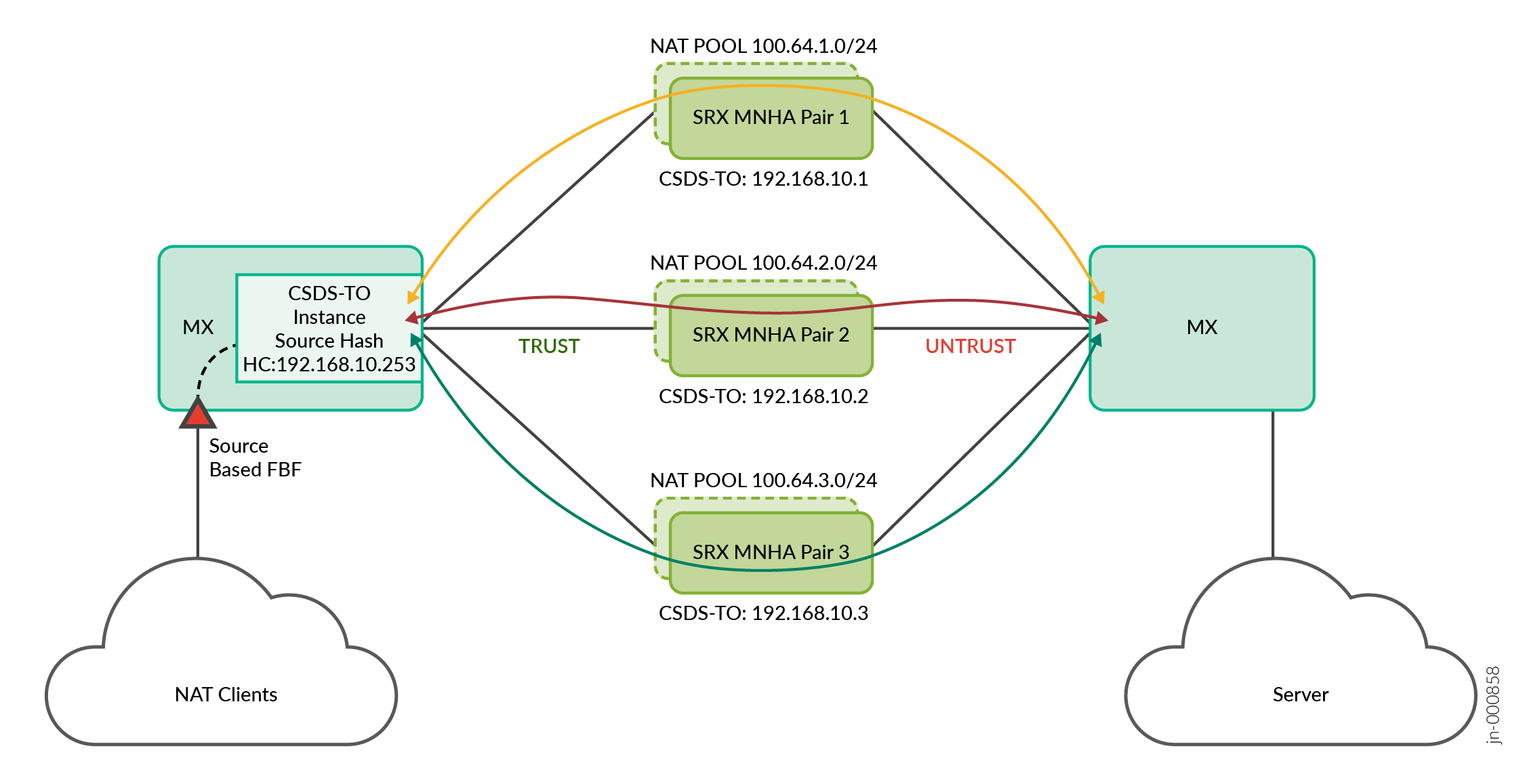- play_arrow CSDS Architecture Overview
- play_arrow CSDS Deployment Overview
- play_arrow CSDS Deployment Scenarios and Topologies
- Deployment Scenarios and Topologies
- CSDS Dual MX Series (ECMP Based Consistent Hashing) and Scaled-Out SRX Series Firewalls (Multinode HA)
- CSDS Single MX Series (ECMP Based Consistent Hashing) and Scaled-Out SRX Series Firewalls (Standalone)
- CSDS Single MX Series (CSDS Traffic Orchestrator) and Scaled-Out SRX Series Firewalls (MNHA)
- CSDS Dual MX Series (CSDS Traffic Orchestrator) and Scaled-Out SRX Series Firewalls (MNHA)
- play_arrow ECMP-Based Consistent Hashing in CSDS
- How CSDS Works with ECMP Based Consistent Hashing
- IPsec VPN Traffic Flow in Single MX Series (ECMP Based Consistent Hashing) and Scaled-Out SRX Series Firewalls (Standalone)
- NAT Traffic Flow in Single MX Series (ECMP Based Consistent Hashing) and Scaled-Out SRX Series Firewalls (Standalone)
- Stateful Firewall Traffic Flow in Single MX Series (ECMP Based Consistent Hashing) and Scaled-Out SRX Series Firewalls (Standalone)
- Stateful Firewall and NAT Traffic Flow in Dual MX Series (ECMP Based Consistent Hashing) and Scaled-Out SRX Series Firewalls (Multinode HA)
- play_arrow Unified Management with JNU in CSDS
- play_arrow vSRX Orchestration with JDM in CSDS
- play_arrow Configure CSDS
- Example: Single MX Series (ECMP Based Consistent Hashing) and Scaled-Out SRX Series Firewalls (Standalone) for IPsec VPN
- Example: Single MX Series (ECMP Based Consistent Hashing) and Scaled-Out SRX Series Firewalls (Standalone) for NAT and Stateful Firewall
- Example: Dual MX Series (ECMP Based Consistent Hashing) and Scaled-Out SRX Series Firewalls (Multinode HA) for NAT and Stateful Firewall
- Example: Single MX Series (CSDS Traffic Orchestrator) and Scaled-Out SRX Series Firewall (MNHA) for Stateful Firewall
- Configure Junos Node Unifier for CSDS
- Install and Configure Junos Device Manager for CSDS
NAT Traffic Flow in Single MX Series (CSDS Traffic Orchestrator) and Scaled-Out SRX Series Firewalls
In this topic, you’ll see how NAT traffic flows in a single MX Series with CSDS Traffic Orchestrator and SRX Series Firewalls.
In this topology for NAT traffic:
- Configure a single MX Series with two interfaces logical interfaces (IFL) for TRUST and UNTRUST routing instances. MX Series CSDS Traffic Orchestrator (CSDS-TO) does health check on all the scaled-out SRX Series Firewalls and builds the next-hop for load balancing the traffic.
- Connect all the scaled-out SRX Series Firewalls to the MX Series with BGP connections.
Configure the MX Series with CSDS-TO on the TRUST routing instance to perform the load balancing of data traffic coming from client-side gateway router towards the scaled-out SRX Series Firewalls.
Each scaled-out SRX Series Firewalls must have a unique NAT pool range, advertised towards the MX Series UNTRUST direction.
Configure unique IP addresses for all the scaled-out SRX Series Firewalls connected to MX Series that is used by CSDS-TO to perform the health check and build up the selector table in the PFE. PFE uses this selector table to load balance the packet across the available next-hops. This health check is reachable through the BGP connection.
The filter-based forwarding on source IP address match is used in the MX Series router to push the NAT specific traffic to the CSDS-TO TRUST forwarding instance.
The CSDS-TO forwarding instance has a default route with next-hop as list of SRX Series Firewalls. CSDS-TO installs this default route when its health check passes with at least one SRX Series Firewalls.
CSDS-TO does source-based hash load balancing across all the available SRX Series Firewall next-hop devices.
Load balanced NAT data sessions are anchored on any available SRX Series Firewalls and NAT flow gets created. Then it is routed to reach the server through MX Series router over UNTRUST routing instance.
For the return traffic coming from server to client direction on the MX Series UNTRUST routing instance, unique NAT pool routes are used to route the traffic to the same SRX Series Firewalls.
The SRX Series Firewalls use same NAT flow to process the return traffic and route the packet towards MX Series Router on the TRUST direction. The MX Series router routes the packet back to the client.
Figure 1 illustrates the step-by-step traffic flow.

The MX Series is a single router configured with multiple logical interfaces towards scaled-out SRX Series Firewalls on the TRUST VR and UNTRUST VR direction.
For the forward traffic coming from client-to-server, the MX Series router uses filter-based forwarding based on the source IP address match to push the NAT traffic to the CSDS-TO TRUST forwarding instance. CSDS-TO forwarding instance includes a default route with next-hop as the list of SRX Series Firewalls. CSDS-TO installs this default route when the health check passes for at least one SRX Series Firewalls.
CSDS-TO performs source-based hash load balancing across all the available SRX Series Firewall next-hop devices.
Load balanced NAT data sessions are anchored on any available SRX Series Firewalls and NAT flow is created.
Then the traffic is routed to reach the server through the MX Series over UNTRUST routing instance.
For the return traffic coming from server-to-client on the MX Series UNTRUST routing instance, unique NAT pool routes are used to route the traffic to same SRX Series Firewalls.
SRX Series Firewalls use the same NAT flow to process the return traffic and routes the packet towards MX Series on the TRUST direction.
MX Series routes the packet back to the client.
For more information, see Juniper Scale-Out Stateful Firewall and Source NAT for Enterprise —JVD, and Juniper Scale-Out Stateful Firewall and Source NAT for Enterprise —JVD.





















